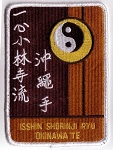Kusanku Dai Bunkai – Shihan Kevin Holton

Isshin Shorinji Ryu Okinawa-te kata Kusanku Dai bunkai, demonstrated by Shihan Kevin Holton and members of the ISR Honbu Dojo, Edison, New Jersey in 2025. Participants include Dr. Holton, Mr. Ms. Stephanie Chee Haiser, Mr. Mike Zuppardo (white uniform with red and white belt), Mr. Steven Haiser and Mr. Juan Flores (black uniforms) and Mr. Rich Gomez (Black and white uniform).
100% Human Generated Content.
Kusanku Dai – Shihan Rod Lindgren

Isshin Shorinji Ryu Okinawa-te kata Kusanku Dai, demonstrated by Shihan Rod Lindgren in 2024, Katy, Texas.
There are 2 forms of this kata, “Dai” and “Sho”. “Dai” is translated either as “greater” or “hard” while “Sho” is translated either “lesser” or “soft”. Most of the Karate world refers to this kata as Kusanku Sho, attributed to “lesser” translation. In this case, the “hard” translation is used, as this form has a much harder beginning than the other form of the kata known here as Kusanku Sho.
100% Human Generated Content.
Kusanku Dai – Shihan Robert Cusumano

Isshin Shorinji Ryu kata Kusanku Dai demonstrated by Shihan Robert Cusumano in 1991. There are 2 forms of this kata, “Dai” and “Sho”. “Dai” is translated either as “greater” or “hard” while “Sho” is translated either “lesser” or “soft”. Most of the Karate world refers to this kata as Kusanku Sho, attributed to “lesser” translation. In this case, the “hard” translation is used, as this form has a much harder beginning than the other form of the kata known here as Kusanku Sho.
Kusanku Dai – 4th Dan Sensei Mr. McNeil

Isshin Shorinji Ryu kata Kusanku Dai, demonstrated by 4th Dan Sensei McNeil in 2024, Jones Martial Arts, Carteret, NJ. There are 2 forms of this kata, “Dai” and “Sho”. “Dai” is translated either as “greater” or “hard” while “Sho” is translated either “lesser” or “soft”. Most of the Karate world refers to this kata as Kusanku Dai as it is listed here. In this case, the “Greater” translation is used, as this form has more moves than the other form of the kata known on this website as Kusanku Dai.
100% Human Generated Content.
Kusanku Dai – Sensei Joe Hageman

Isshin Shorinji Ryu kata Kusanku Dai demonstrated by Sensei Joe Hageman in 1984. There are 2 forms of this kata, “Dai” and “Sho”. “Dai” is translated either as “greater” or “hard” while “Sho” is translated either “lesser” or “soft”. Most of the Karate world refers to this kata as Kusanku Sho, attributed to “lesser” translation. In this case, the “hard” translation is used, as this form has a much harder beginning than the other form of the kata known here as Kusanku Sho.
Kusanku Dai – Sensei David Carr

Isshin Shorinji Ryu kata Kusanku Dai demonstrated by Sensei David Carr in 1991. There are 2 forms of this kata, “Dai” and “Sho”. “Dai” is translated either as “greater” or “hard” while “Sho” is translated either “lesser” or “soft”. Most of the Karate world refers to this kata as Kusanku Sho, attributed to “lesser” translation. In this case, the “hard” translation is used, as this form has a much harder beginning than the other form of the kata known here as Kusanku Sho.
100% Human generated Content,
Kusanku Dai – Sensei Rod Lindgren

Isshin Shorinji Ryu Okinawa-te kata Kusanku Dai, demonstrated by Sensei Rod Lindgren in 2012. La Mesa, California.
There are 2 forms of this kata, “Dai” and “Sho”. “Dai” is translated either as “greater” or “hard” while “Sho” is translated either “lesser” or “soft”. Most of the Karate world refers to this kata as Kusanku Sho, attributed to “lesser” translation. In this case, the “hard” translation is used, as this form has a much harder beginning than the other form of the kata known here as Kusanku Sho.
Donate Crypto-currency

 |  |  |

Wallet address of bitcoin
13JDhP1YScpJosCbkXwWUeS

